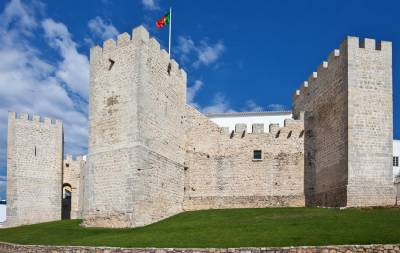
Loulé travel guide »
The quaint, traditional market town of Loulé, located about 15 kilometres north of Faro, in the Algarve, was originally founded as a Roman fort, probably in the second century B.C., but began to truly flourish...
The castle at Loulé formed what would have been the northwestern corner of the city walls. What remains of the original castle are the gate tower and three further towers along with the walls that connect them. All seem in remarkably good condition, and this is largely due to the extensive restoration work during the 19th century.
Loulé Castle suffered extensive damage during the 1755 great earthquake and was again damaged by a much lesser earthquake in 1969.
Along with many of the Algarve's other castles, Loulé's dates back to...
The 17th century whitewashed church of São Lourenço de Amancil is somewhat unusual in appearance having more features than most churches of its size. To one side there is a bell tower to which a long staircase rises from the front of the building. The corners of the roof are decorated with pinnacles and adjacent to the bell tower is a copula.
What really marks São Lourenço out though is the interior and particularly the azulejo work. These characteristic blue tiles are both noteworthy for their age and their quality - dating back to 1730 they have been attributed to one of the...
Situated around 2km inland from Quarteira is the Aquashow Park, a huge complex centred around one of Portugal's largest water parks.
Aquashow is home to a good selection of water-based rides suitable for a range of ages. From adrenaline-fueled free fall slides to just bobbing around.
The rides themselves are all various combinations of slides, chutes and flumes with or without inflatable tubes. Where they vary is how high, twisty and fast they are but all finish with you shooting out of the end into a pool.
At the fastest end of the scale are the White Fall and new...
A 10 kilometre drive inland from Faro town centre, the sleepy town of Estoi features some of the Algarve’s best preserved Roman ruins. The Milreu site, just off the N2 highway, was excavated in 1877. The oldest part of the Roman ruins are thought to date back to 1st or 2nd century A.D. with a large villa and temple being added later, probably in the third century.
Vilamoura, with its interesting archaeological ruins, was once an important Roman fishing centre. Today, tourists flock to the area thanks to the sandy beaches and year-round sunny weather. But Vilamoura also pulls in the yachting set and the marina here is the largest in Portugal.
Vilamoura Marina was inaugurated in 1974 and is capable of berthing more than 1000 boats. Unlike the majority of Portugal's other marinas, Vilamoura is known for its glitz rather than seaside charm. This makes it the popular choice for the super-rich looking for a place to berth their...
The Cerro de Vila museum is located near the Quarteira suburb of Vilamoura, on the Algarve coastline. Some pretty interesting Roman archaeological excavations are to be found here, with most of the ruins located within the museum complex.
The site had been occupied by humans since the Bronze Age, but the Romans were the first to establish a large-scale, permanent settlement here in the year 27BC. Two large Roman villas were located at the site; today fragments of the walls can be seen alongside sections of mosaic. The ruins of the bath-...
If you fancy a flutter or a chance to rub shoulders with the footballers who have homes nearby, the Casino in the Quarteira coastal suburb of Vilamoura might be worth a visit.
The casino has twelve live table games (5 roulette, 4 blackjack and 3 Portuguese dice) as well as an area with 4 tables of Texan poker. The minimum bet at the roulette table is for €5. There are over 500 slot machines.
As well as the gaming on offer here, there are daily dinner cabaret shows, a restaurant, bars and the popular Blackjack Disco. The food and drink here is quite...

The quaint, traditional market town of Loulé, located about 15 kilometres north of Faro, in the Algarve, was originally founded as a Roman fort, probably in the second century B.C., but began to truly flourish...